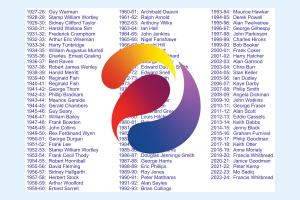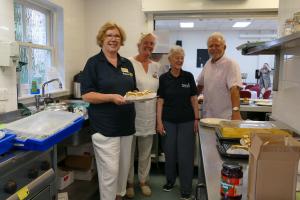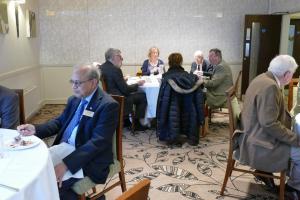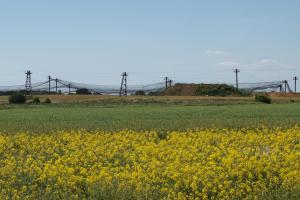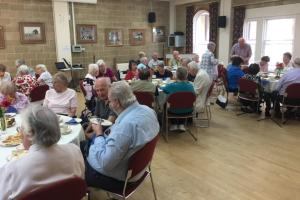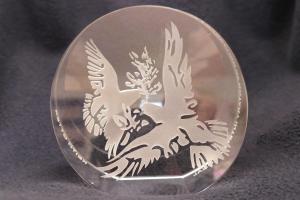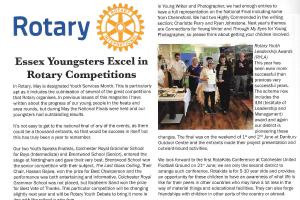Tom Harper: Murder at any cost?
Thu, Nov 28th 2019 at 1:00 pm - 2:15 pm
We thought about murder most foul!
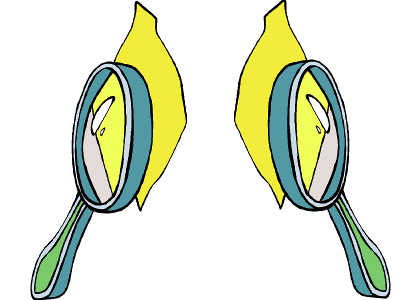
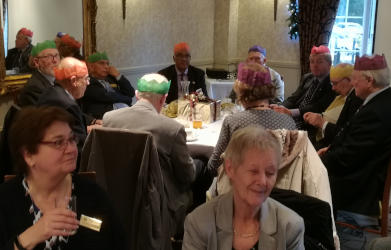 We had an unexpected bonus today. When we arrived at the Ivy Hill Hotel we discovered that they were already in the Christmas spirit with the tables decorated appropriately. We even had Christmas crackers containing excruciating jokes and paper crowns. (See the photograph.) The main course was roast turkey but for dessert we had treacle pudding instead of Christmas pudding. That brought back memories of our childhoods to some of us!
We had an unexpected bonus today. When we arrived at the Ivy Hill Hotel we discovered that they were already in the Christmas spirit with the tables decorated appropriately. We even had Christmas crackers containing excruciating jokes and paper crowns. (See the photograph.) The main course was roast turkey but for dessert we had treacle pudding instead of Christmas pudding. That brought back memories of our childhoods to some of us!
Our speaker was Rtn Tom Harper from the Rotary Club of Chelmsford Mildmay. He spent 40 years in the police and retired from the Essex Police as Detective Chief Inspector in charge of forensic investigations.
He told us about one murder investigation in which he had been involved. This was the murder of a vulnerable man in Castle Park in Colchester. His body was found by a woman walking through the park on her way to work early the following morning. In her telephone call to the police she said she had found a man’s body covered with blood.
When the police arrived they found that the man was, amazingly, still alive. They tried to bring him round and called in paramedics, who finally declared him dead some fifteen minutes after they got to the scene.
By the time Tom and his team arrived the area had been secured. The first officers there had flagged possibly relevant items they had noticed with small numbered yellow cones. They had then withdrawn from the immediate area to avoid disturbing it further. The paramedics had left but the body remained where it had been found, although it had been disturbed when the paramedics tried medical interventions.
The forensic team’s first priority was to try to identify everything at the scene that might be relevant to the murder enquiry and make sure it was preserved. This even included any small hairs found on the body or the victim’s clothing and some 167 cigarette butts discovered in the vicinity, as well as eight knives. The only way of preserving the extensive blood stains was to physically remove the tarmac surface of the path. The same thing was done with 24 bloody footprints found leaving the area.
There was then an extensive search through the material to see what should be sent away for forensic testing. Most of the 167 cigarette butts were discarded as too old to be relevant, but that still left 60 to be tested at a cost of £185 each. At one time each police force had its own forensic labs and resident scientists but, after they were criticised as not being sufficiently independent, the government of the day set up a National Forensic Science Service. This too was eventually closed in favour of privately-owned forensic services which were completely independent of the government or any police force. However, each of the 25 forensic science companies is in the business to make a profit. The previous forensic services simply had to break even.
Hence the title of Tom’s talk: “Murder at any cost?” Decisions had to be made as to how much of the forensic team’s budget should be spent on any particular investigation.
In the murder case Tom described to us, a lot of forensic work was necessary. The victim had 120 stab wounds, indicating that there was a frenzied attack in which the attacker must have suffered some cuts himself. The bloodstains had to be analysed to see whether any did not belong to the victim and were therefore likely to have come from the attacker.
Advice also had to be taken regarding the footprints that had been found. What sort and size of shoe had the attacker worn? A number of suspects’ homes were searched for anything which might identify them as the killer. This involved taking away many pairs of trainers that were the same size and make as those worn by the attacker. Any soil samples on the shoes had to be compared with those taken from the murder site and shoes and clothing collected from suspects meticulously examined for possibly relevant stains or damage. Knives were also collected to see whether they could have made the stab wounds found on the victim’s body.
A single spot of the victim’s blood was found on the killer’s trainers. He was arrested and convicted, but unfortunately not before he had killed another victim. The cost of the murder investigation was in the region of £5,000,000, of which £247,000 related to the forensic work Tom had overseen.
Tom was asked whether the killer would have been caught in the days before modern forensic techniques. Tom thought he would have been because he seemed to have a compulsion to kill and would inevitably have been identified - but possibly only after committing further murders.
